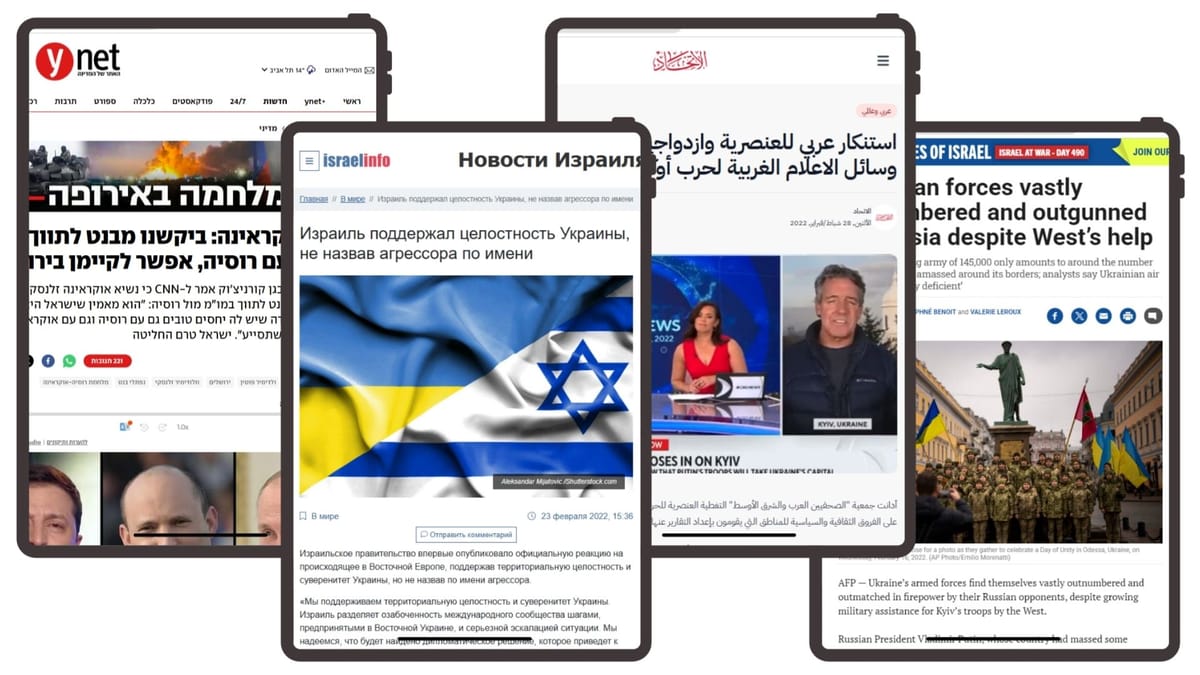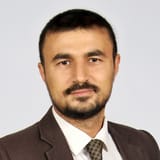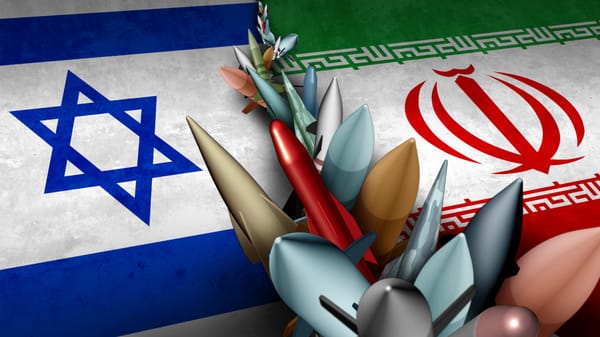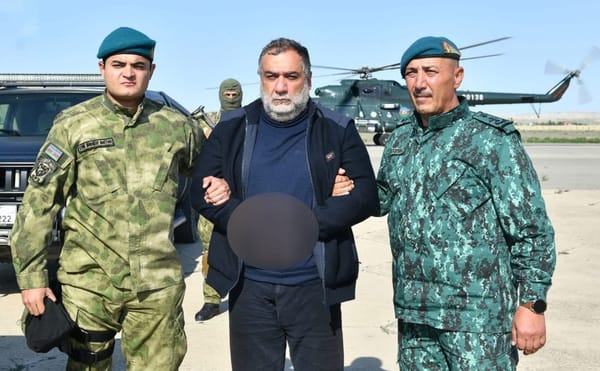How One War Resounded in Four Languages?

What Did Hebrew-, English-, Arabic-, and Russian-Language Israeli Publications Write About the Start of Russia’s Aggression Against Ukraine, and Why Were Their Assessments and Emphases So Different?
Three years ago, in late February 2022, a full-scale war broke out between Russia and Ukraine. For Israel, those days were marked by tense efforts to balance its policy toward Russia, maintain ties with the United States and the European Union, aid potential immigrants from Ukraine, and at the same time avoid direct involvement in the conflict.
How were all these themes reflected in our multilingual media space? Why did Arabic-language outlets almost ignore this war, Hebrew-language outlets struggle to reconcile solidarity with Ukraine and a reluctance to call Russia an aggressor, English-language publications describe a “barbaric invasion,” and Russian-language outlets prove to be the most anti-Russian of all?
I am currently researching journalistic strategies for covering internal and external conflicts in the Israeli press. The Russia–Ukraine war is one of my case studies, and in this article, I would like to share some of my initial findings.
Domestication of War Reports: Why ‘Taming’ the News Matters and How to Do It Correctly?
Modern media do more than merely inform readers of the facts: they also shape the framework through which events are perceived. This is particularly evident when reporting on wars in distant regions that do not directly affect the lives of the media audience. If hostilities occur “somewhere far away” with no immediate local impact, journalists must tailor the narratives they deliver to the needs, interests, and social stereotypes of their readers. This process is referred to as “domestication”—that is, the taming of foreign news, the adaptation of unfamiliar content into a “domestic” form.
In a multilingual and multicultural country—such as Israel—domestication is further complicated by the fact that each linguistic community has its own unique stereotypes, cultural codes, and historical experiences. For a small country like Israel, this diversity is striking: it ranges from the Arab Middle Eastern mindset to the social practices of immigrants from the former Soviet Union, a large diaspora that maintains close ties with both Ukraine and Russia. Add to this the English-language press oriented toward international and foreign readerships within Israel, as well as Hebrew-language media serving as the mainstream core of the Israeli press.
The result is that the same event—the start of the war between Russia and Ukraine—was covered in Israel’s media landscape by four notably different voices.
Hebrew-Language Press: Detailed Coverage and Measured Condemnation
Leading Hebrew-language newspapers—Haaretz, Yedioth Ahronoth, Maariv, Israel Hayom—from the first days of Russia’s invasion of Ukraine devoted considerable attention to its implications for Israel. Public interest in the war arose from a mix of geopolitical factors—Russia’s role in Syria, the balance of relations with the United States, and other considerations, including the plight of Ukraine’s Jewish communities urgently seeking a path to immigration. Articles covered the movement of Russian forces, the fate of civilians, and the Western sanctions promised against Russia. Yet the coverage also reflected the Israeli government’s cautious foreign policy line, avoiding overly harsh statements toward Moscow.
Particular attention was paid to the personal dimension of the conflict. Accounts of Kyiv Mayor Vitali Klitschko, President Volodymyr Zelensky, and other recognizable figures created an emotional bridge between Israeli readers and events in Ukraine, making the war feel less abstract. Articles in Hebrew drew parallels with Israel’s own history of military conflicts. Klitschko’s image echoed that of “a new Ariel Sharon,” fighting for his country’s independence. The Ukrainian military was portrayed in a manner reminiscent of the heroes of Israel’s past wars. This technique—personalizing a distant conflict—helped Israelis feel that Ukraine was kindred in spirit, thereby heightening readers’ emotional engagement.
Another set of coverage involved interviews with rabbis and community leaders from Ukraine’s Jewish population, reinforcing the message: “We must help them, because they are our people in need of protection.” In parallel, the press analyzed Israel’s complicated position, obligated to juggle its alliance with the United States while maintaining dialogue with Russia over the situation in Syria (still relevant at the time).
Hence, the Hebrew-language newspapers built a multilayered narrative, combining reports on military developments with ethical and political reflections. Overall, the tone in the Hebrew-language segment underscored that Israel could not afford a sharply anti-Russian stance but was nevertheless bound to acknowledge the fact of Russian aggression against Ukraine. Consequently, the Israeli press depicted Ukraine as a victim worthy of sympathy and support, while portraying Russia as a disruptor of the “world order” whose actions merited condemnation—albeit without complete diplomatic ostracism.
English-Language Press: A Connection With the Global Reader
English-language outlets—The Jerusalem Post, The Times of Israel, Haaretz (English), Israel Hayom (English)—are aimed at both local and international readers of English, for whom the war in Ukraine carries global significance. Their reports on the conflict largely approached it through the lens of international politics. News dispatches and military updates were presented with maps of Russian troop movements, accompanied by comments from European and American officials, along with statements from NATO countries. In this framework, Israel appeared as one of the major regional players grappling with the complexities of that geopolitical and diplomatic situation.
Compared to the Hebrew-language media, these English publications used more pointed language, employing terms such as “barbaric incursion” and “Russian aggression.” Yet discussions of Israel’s official position remained noticeably restrained in tone. This reflected Israel’s own cautious foreign policy approach while still allowing readers to draw clear conclusions about the nature of the war.
As in the Hebrew press, substantial emphasis was placed on the humanitarian aspect—particularly the plight of Ukrainian refugees, the scale of international aid, and statements from high-level EU and U.S. officials. Considerable coverage was devoted to a surge in applications to the Jewish Agency by Ukrainian Jews seeking to immigrate. These articles shaped a dramatic narrative of a tragedy whose perpetrator—the Russian government—was unmistakable to any English-reading audience.
Thus, in addressing the outbreak of Russian aggression against Ukraine, the English-language segment of Israel’s media functioned like a mosaic: on the one hand, it maintained a decisive tone reminiscent of Western journalism; on the other, it stayed consistent with Israel’s diplomatic balancing act. Although criticism of Putin and his decisions was sharper here than in Hebrew-language papers, it stopped short of calling for a total severance of relations with Moscow.
Arabic-Language Press: Minimal Interest and Criticism of ‘Double Standards’
In Arabic-language outlets—Panorama, Al-Ittihad, As-Sonara, Kul al-Arab—the onset of the war in Ukraine received far less attention than it did in newspapers in other languages. The limited articles that did appear tended to address the war only indirectly. For Israel’s Arab readership, the Ukrainian conflict was not a priority, overshadowed by developments in the Middle East. Moreover, the modest resources of these Arabic community publications restrict their ability to undertake extensive foreign coverage, which also influenced their approach to the conflict in Ukraine.
One of the few pieces told the story of Manchester City footballer Oleksandr Zinchenko, who reacted strongly to the invasion. The article focused on his personal emotions and contained little deeper analysis of the hostilities. Another commentary highlighted what the author saw as the Western media’s “double standards,” contending that coverage of the war in Ukraine showed a traditional sympathy for European refugees while overlooking the suffering of Arabs and Africans in numerous other conflicts.
In short, for Israel’s Arabic-language press, the start of the war in Ukraine was a peripheral topic. Given that these outlets’ primary audience is traditionally centered on Palestinian issues and Middle Eastern events, this focus is understandable. As in the past, regional developments with direct implications for Israel’s Arab population outstripped the relevance of a conflict in distant Europe.
Russian-Language Publications: Sympathy for Ukraine, Yet Without the ‘Kremlin Narrative’
Russian-language outlets in Israel, such as Vesti, Detali, Israel Info, Mig News, found themselves in a complicated position from the early days of the conflict. On the one hand, their articles clearly acknowledged that Ukraine had been attacked without provocation. On the other, there was concern over the potential fallout of overly strong criticism directed at Putin—particularly regarding Russia’s cooperation with Israel in Syria. The question “Will we create a problem for ourselves with Russia in the north?” often surfaced, reflecting the Israeli establishment’s anxiety about a possible deterioration in relations with Moscow.
Yet the dominant theme in Russian-language coverage was not geopolitics but the human dimension. Stories about immigration and refugee assistance took center stage: lines outside consulates, evacuation flights, and personal accounts of Israelis trapped in Kharkiv or Odesa. For Russian-speaking readers, this war was not just a global crisis but also a personal one, affecting family and friends back home. In this respect, these outlets’ reporting was more emotionally charged than that of the other language sectors.
Moreover, Israeli Russian-language media carried virtually no caricatured tropes found in Russian state propaganda. Narratives about “Nazis in Kyiv” or the “oppression of Russian speakers” appeared solely in the context of describing the Kremlin’s official position. Criticism of Russia’s invasion was cautious yet consistent.
As a result, Russia-oriented newspapers in Israel formulated a stance that generally paralleled that of the leading Hebrew-language outlets: condemning the war, empathizing with Ukrainians, and using measured language whenever Israel’s strategic interests in Syria were involved. At the same time, this Russian-language sector displayed a special focus on repatriation and refugee assistance, making the war in Ukraine not only a political issue but also a deeply personal matter for its audience.
Comparative Summary: Four Different ‘Israels’
Israel’s media landscape—with the exception of the Arabic segment—exhibited a largely unified view of the main contours of the Russia–Ukraine war. All of the major outlets emphasized that Russia had initiated the conflict, expressed sympathy toward Ukrainian refugees, and displayed a keen interest in the predicament facing Ukraine’s Jewish communities. Yet they also made clear Israel’s restrained governmental position: condemning the aggression without severing diplomatic ties with Moscow.
The differences in the depth and breadth of coverage can be summarized as follows:
- Hebrew: The most extensive analysis, including parallels to Israel’s constant military threats, potential mediation efforts, and opinions by military analysts on “conventional warfare.”
- English: A blend of forceful terminology (“barbaric invasion”) and diplomatic caution; broad coverage of U.S. and EU efforts to rein in Russia.
- Russian: Focus on repatriation, the fate of “our own” (relatives, acquaintances), and tempered criticism of Moscow; an outright absence of pro-Russian propaganda that was prevalent in Russia’s state media.
- Arabic: Almost complete marginality of the topic; only two articles that served mainly as a pretext for highlighting perceived racism in Western media and for sports-related stories.
Hence, the tension between solidarity with Ukraine and diplomatic pragmatism became the defining theme of Israel’s media discourse. Israel could not afford to take a firm stance against Moscow because of its strategic interests in Syria, yet it could not remain entirely neutral in the face of clear-cut aggression, both on moral grounds and under pressure from the then-current U.S. administration. As a result, most segments of the press (with varying levels of intensity and excepting the Arabic sector) converged on a median narrative: “We support Ukraine but must also act in line with our national security needs and diplomatic realities.”
Conclusions: What We Can Learn From Israel’s Experience With Multicultural Journalism
Israel’s media landscape showed that a society’s multilingual and multicultural composition can generate numerous, distinct narratives. The same event—the start of the war between Russia and Ukraine—gave rise to four different interpretations within a single country. Hebrew- and English-language outlets offered the most in-depth analysis, Russian-language outlets focused on emotional impact and the plight of “their own” refugees, and the Arabic press largely ignored the issue. This division starkly illustrates how multiple “information bubbles” can coexist even in one state.
The principle of domestication was evident in how each audience viewed the war through its own historical references, linguistic codes, and lived experiences. Israeli media recognized these differences and tailored their content accordingly. The formulation of categories—“Us” and “Them”—was guided by readers’ expectations, influencing editorial focus and the tone used to depict events.
Throughout this, the press balanced expressions of solidarity with strategic caution. In a war that Israel could not regard with indifference, it adopted a posture of “cautious sympathy” toward Ukraine. Its condemnation of Russia’s aggression was present but dampened by diplomatic considerations relating to Israel’s need to maintain a working relationship with Moscow.
A striking aspect was the near-total absence of Kremlin-style propaganda in Russian-language outlets. Although one might have anticipated narratives about “Nazis in Kyiv” or “malevolent NATO,” these did not appear. The country’s competitive media environment effectively kept the so-called “Kremlin playbook” out of Israeli newspapers, which stands in contrast to the dominance of such views in Russia’s state-controlled media.
The humanitarian angle of the conflict also played a vital role. By highlighting stories of Jewish refugees and calls to help “our own,” the war ceased to be a distant tragedy and instead took on a personal dimension. This perspective brought Hebrew-, English-, and Russian-language media closer together, while the Arabic press remained focused on local issues, treating the war in Ukraine as just one of many European crises with little bearing on Middle Eastern affairs.
Israel’s coverage of the Russia–Ukraine war shows that, in a multicultural society, each linguistic community receives its own “version” of the news. Meanwhile, Israeli state institutions and politicians avoided making bold statements, and although journalists used varying degrees of emotional language, they conveyed sympathy for Ukraine, underscored the threat that Russia’s actions posed to world order, and dedicated considerable attention to the refugees and the broader issue of repatriation.
In essence, in the information realm, Israel emerged as a “cautious ally of Ukraine.” Yet its media space also demonstrated a profound lack of uniformity, underscoring how the mosaic of cultural and linguistic diversity shapes distinct media narratives even when addressing the same global event.
You can download the text of this article in English or Russian at the link below.







